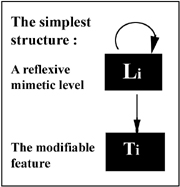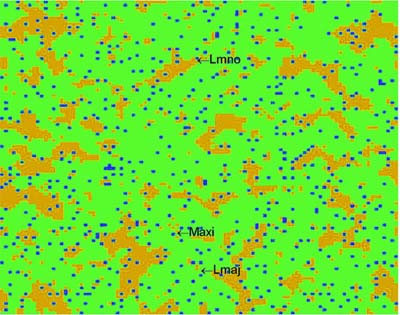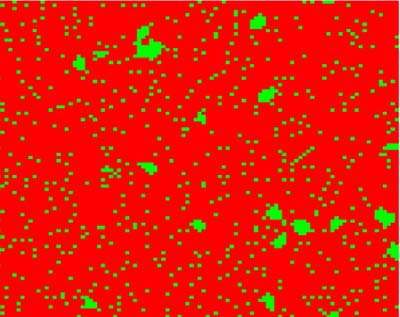The direct extention of Nowak and May's Model
The aim of these pages is to présent the direct extension of the model of Nowak and May 1992 in the metamimetic framework. We will thus see that similar dynamics to the case of the metamimetic prisonner dilemma game are found. Here, the set of rules is not symetric : the symetric rule of maxi (mini) is not present. This is the reason why in this example cooperation is not as successful as in the case of symetric set of rules.
Parameter of the game are the following :
| Matrix Game | C | D | Population size : 10 000 |
Self-Interaction as in Nowak and May 1992 | initial distribution of imitation rules: uniform |  |
|||
| C | 1 | 0 | |||||||
| D | b | 0 |
Here, we will take b=1.9 and an initial rate of coopération IniCoop=0.5. :
We have here parameters of a chaotic regime in the original model. The following graphs show the evolution of a particular simulation. The simulation results are shown until time step 300 since dynamics don't change any more after this time. The most interesting phenomena take place at the beginning. The first striking thing is that the system reaches very quickly its unique attractor (20 periods), which is mostly static (for a 10000 agent population, about a hundred oscillators at the level of imitation rules, less than a dozen at the behavioral level (see fig 1).
The proportions vary among the different types of rules for imitation (fig2):
If we now look at the spatial distribution of the agent’s modifiable features (fig. 3&4), we can notice a very strong structuration with the formation of clusters of the different types.
 |
 |
Figure 3: The mimetic level at the asymptotic state, we can see clusters of Maxi in a sea of conformist with non-conformist scattered. PDR has completely disappeared. Each small square represents one agent. |
Figure 4: The behavioral level at the asymptotic state. Clusters of cooperators are here mostly composed by conformist agents. They have been induced by local fluctuations in the distribution of cooperators and cooperating non-conformist-agents on the border of the cluster. |
As for the correlation between the imitation rule used by an agent and his behaviors, it can be seen in fig 5 . that the only cooperators are either non-conformist agents (with a mean rate of cooperation of .97) or conformist agents (with a mean rate of cooperation of .04). non-conformist agents seem to have some role in stabilizing conformist clusters of cooperators. They occupy positions at the border of these clusters where C-behaviors are in minority, stabilizing this border. Without these non-conformist-agents, these clusters should have been much smaller.
If we now look at the mean payoffs per imitation rule (fig. 6 ), we see that Maxi-agents are actually the one winning the most, with a short advence. On the other hand, cooperative behaviors are winning the most in mean (fig. 7 ). This is due to the fact that a D-agents surrounded by other D-agent wins nothing (cf. the matrix of the game). There are thus large clusters of D-agents winning nothing. To see this, we can see the spatial distribution of payoffs (fig. 8). We can notice, comparing fig 4 and fig 4, that red areas (highest payoffs) correspond to clusters of cooperators. In the perspective of emergence of cooperation, this result is interesting and show how in the metamimetic framework, cooperation can appear locally with the formation of small clusters which will have an evolutionary advantage. The spatial structure of neighborhoods and cognitive capacities of agents in selecting theirs partners and strategies are however too poor in this game to give further conclusions on this topic.
Fig. 8: Spatial distribution of payoffs. Blue : lowest payoffs, red : highest payoffs.
We made the precedent study for the initial rate of cooperators Ci ranging between 0.1 and 0.9 and for b in [1.2 , 2.5]. 3D graphs from this study can be found in Annexe 2.
Fig. 1 : Evolution of the hamming distance between 50 time step. (click to enlarge)
Fig 2 : Evolution of the proportions of imitations rules. (click to enlarge)
fig. 5: mean rate of cooperation per imitation rule.
Fig 6: mean payoffs per imitation rule.
Fig 7: mean payoffs per action.




